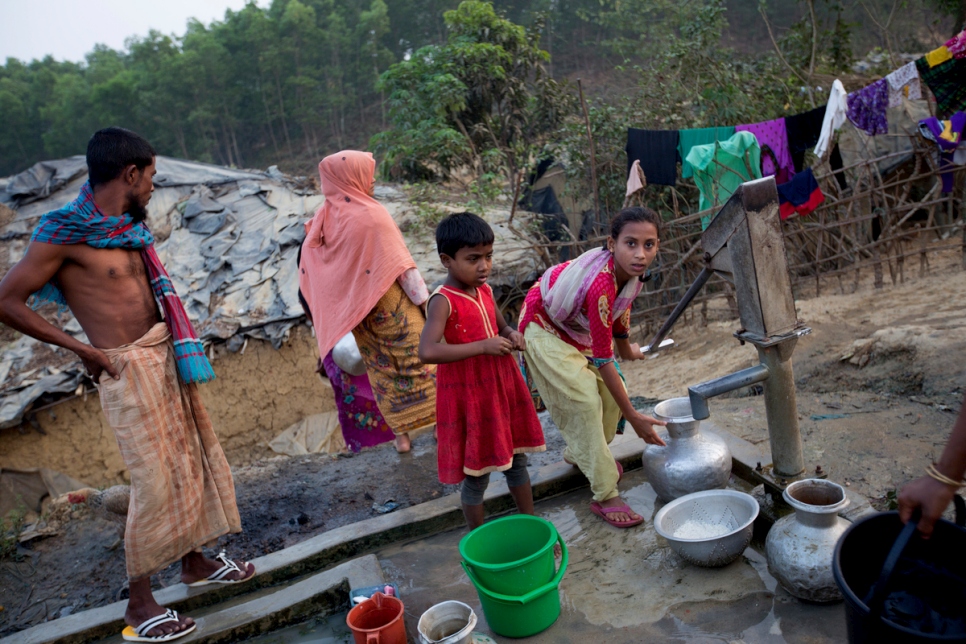UNHCR seeks equal treatment for all Rohingya in Bangladesh
A small proportion who fled violence decades ago are considered refugees, while many recent arrivals remain undocumented and miss out on vital aid.

In some makeshift sites around Bangladesh's Cox's Bazar area, humanitarian agencies have built tube wells that provide a much-needed source of drinking water for undocumented Rohingya living outside the official camps. © UNHCR/Saiful Huq Omi
UKHIYA, Bangladesh - At a glance, Mostafa and Sohel* have a lot in common.
As a young man in 1992, Mostafa fled violence in the northern part of Rakhine state in Myanmar to seek refuge in Bangladesh.
Twenty-five years later Sohel took the same journey. After weeks of violence amid a security operation in his village, the 22-year-old had to be carried across the Naf River to safety earlier this year, his body burnt and swollen.
Pointing to the scars on his feet, Sohel said: “They beat us senseless and left us to die in a ditch. We were five people in the group, only three survived.”
Both men found refuge in Bangladesh, where Mostafa recently guided Sohel to a hospital to received treatment for his injuries. But despite their common Rohingya background and circumstances, Mostafa and Sohel are being treated very differently.
"They beat us senseless and left us to die in a ditch. We were five people in the group, only three survived.”
As part of the influx of refugees in the early 1990s, Mostafa is among 33,000 registered refugees living in two government-run camps serviced by UNHCR, the UN Refugee Agency, and its partners in south-eastern Bangladesh.
He has a home in Kutupalong camp and access to basic services including food assistance, healthcare and education for his wife and three children. Now in his 50s, he has learnt to speak English well and is working as a photographer in the camp.
In contrast, Sohel has no legal status in Bangladesh as one of more than 70,000 Rohingya new arrivals who are believed to have fled a security operation between October 2016 and February 2017. He lives with people from his home village and keeps a low profile. He receives ad hoc assistance if he is lucky.
A third category consists of an estimated 200,000 to 500,000 undocumented Rohingya who arrived in Bangladesh between the two influxes. They live in makeshift sites and local villages, and until recently had no access to humanitarian aid.
“The current situation is not sustainable,” said Shinji Kubo, UNHCR’s Representative in Bangladesh. “Regardless of when they came and where they live, these people have the same needs and deserve equal access to protection and assistance.”

Recent arrival Sohel (left) shares his experiences with long-stayer Mostafa (centre) as a UNHCR worker listens in. © UNHCR/Vivian Tan
The new influx has highlighted the urgent need to verify the number and location of the new arrivals. Without this information, vulnerable refugees risk falling through the cracks while others could be receiving duplication of assistance.
“We are advocating for a joint verification of the new arrivals with our partners as soon as possible,” said Kubo. “This exercise will help the government and humanitarian agencies to better target assistance to those who need it the most, be they new arrivals, refugees who came earlier or locals who host them.”
UNHCR works with humanitarian agencies such as the International Organization for Migration and the World Food Programme in Cox’s Bazar.
Several thousand new arrivals are believed to be hosted in the two official camps, straining the capacity of existing refugees and the infrastructure. The water supply in Nayapara camp is expected to run out by the end of March and there are fears of disease outbreaks as a result of overcrowding and poor sanitation.
Many more new arrivals are living in existing makeshift sites or new ones that have sprouted spontaneously.
In Ukhiya district, a site called Balukhali has emerged in the last two months and now hosts 1,600 families, according to a local politician helping them. Located beyond some rice fields, it is a mish-mash of flimsy shelters and latrines made of thin plastic sheets, dried leaves, tree branches and bamboo. These structures could constitute safety and health hazards unless proper site planning is undertaken.
"We hope that all Rohingya in Bangladesh can be documented to ensure full respect for their rights.”
Miriam*, 65, has just moved to Balukhali with her son’s family. “We were living in a local village for more than two months but the leader said we can only receive assistance if we go to a camp,” she said as her son cleared some land to build a shelter. “We have nowhere else to go, we’ll have to stay here.”
The Bangladesh government has announced it will extend a 2016 census of undocumented Rohingya living outside the two camps to include the new arrivals.
“In the long run, we hope that all Rohingya in Bangladesh can be documented to ensure full respect for their rights,” said UNHCR’s Kubo. “Knowing the profile of this population will also help us to identify longer-term solutions for them.”
Despite his traumatized state, Sohel is clear about one thing: “Here I am living in someone else’s house and I worry about the future. If we are given status in Myanmar, we will definitely go back.
*Names changed for protection reasons
